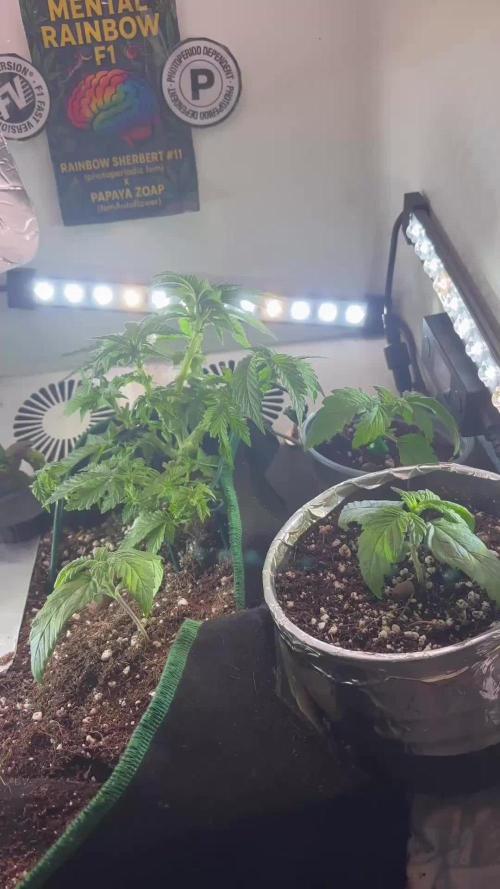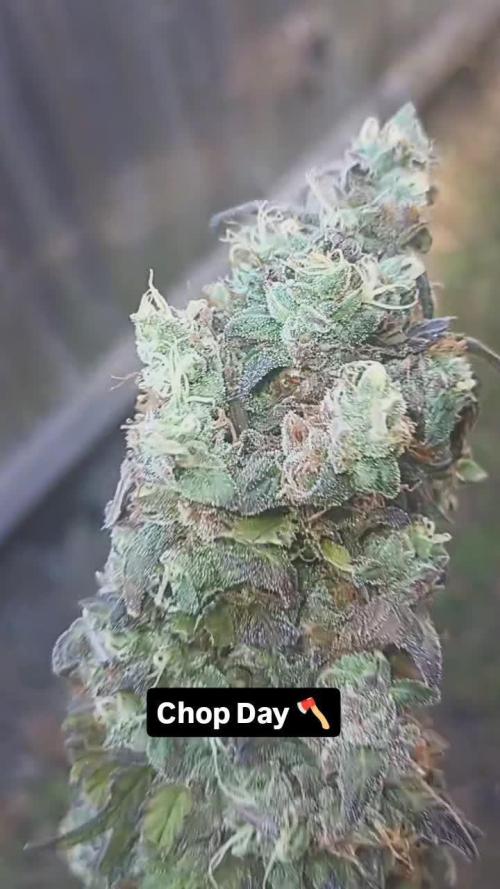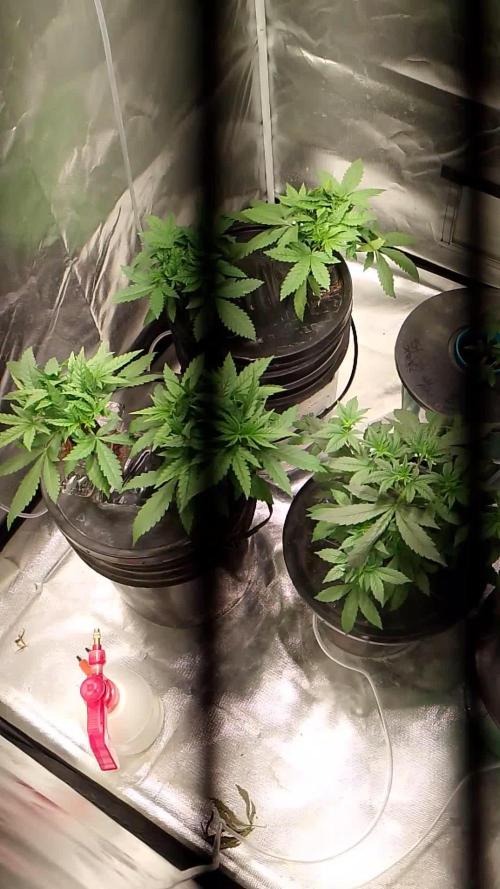The Grow Awards 2026 🏆 































Likes
Comments
Share


@Barzenegger
Follow
The overfeeding on the center plant becomes apparent, but it still takes me a while to realize it and I kept feeding it the tomato fertilizer.
Likes
14
Share


@ApothecAries
Follow
I used half the recommended dose of Indo products for each plant through this grow. The monkey juice is half recommended making it every week rather than full dose every two. The sticky bandit was fed with it every week at half dose till later on.
Processing
Likes
5
Share


@Ensign420
Follow
Week 02 Introduction
This week has been a bit of a struggle. Had my first experience dealing with slime and brown algae. But I think adding enzymes and increasing the beneficial bacteria helped to fix the issue. Also experienced nutrient burn for the first time. My nutrient solution strength got as high as 671 PPMs. So backed it down to about 430 PPMs during the end-of-week reservoir change. Also cut Hydroguard (expired?), CaliMagic, and Superthrive from this grow. Now she's still stunted, but is starting to recover. Hopefully...
[START OF WEEK 02]
Day 01 - Monday - 08/10/20 - Total Days: 008
-----------------------------------
- [0830]: Still looks a bit yellow. But getting larger!
--- Solution strength was at 248 PPMs.
--- Just topped off with a bit of distilled water
--- PH went up to 6.1 so PH'd down to 5.8
--- Ran the top feed for a bit to wet the hydroton.
- [2130]: She's looking even more yellow now.
--- Even the new leaves are really yellow.
--- Decided to add more base nutes.
--- Added 4ml of Sensi A
--- Added 4ml of Sensi B
--- Now at about
--- Solution Strength went up to 304 PPM.
--- PH was at 6,
--- Also raised the water level a bit more.
--- I really hope it's a nutrient deficiency and not an over-watering issue.
--- Please live!
Day 02 - Tuesday - 08/11/20 - Total Days: 009
-----------------------------------
- [0830]: Looking less droopy. But still yellow.
--- Decided to do a reservoir change.
--- 4.5gal of distilled water
--- 8ml of Sensi Grow A
--- 8ml of Sensi Grow B
--- 8ml of Voodoo Juice
--- 4ml of B-52
--- 4ml of CaliMagic
--- 4ml of Hydroguard
--- 4 drops of Superthrive
--- PH'd down to 5.8
--- Solution strength: 302 PPM
--- Since I didn't want to risk over-watering the rockwool, I did not to do a top feed, may do one tonight after the sleep cycle (lights are still set to go off at 10am and back on at 4pm).
--- As I was doing a reservoir change, I noticed that the tubes and bucket were a bit slimy. Didn't really stink or anything. Is this normal? Maybe due to the Hydroguard and Voodoo Juice?
--- I hope she gets better soon!
- [2215]: Getting larger! But still yellow.
--- Also can see a root growing through the net pot! Tiny little thing but it's there! Will have to start dropping water once more appear.
--- After looking over a few DWC diaries using AN nutes, seems like my solution strength is still too low. Most around this stage average around 500 PPMs with about 4ml per gallon.
--- Top fed for a minute to wet the top of the hydroton.
--- Solution strength went down to 263 PPM.
--- Added 8ml more of Sensi A
--- Added 8ml more of Sensi B
--- Now base nutes are at 16ml for 4.5 gal of water.
--- PPMs went up to 411.
--- Still lower than 500 PPMs, but that's okay.
--- PH was at 6. Not sure if I should adjust PH using AN nutes. So going to not ajdust unless PH goes above 6.1.
Day 03 - Wednesday - 08/12/20 - Total Days: 010
-----------------------------------
- [0830]: Looks like more root growth!
--- She still looks yellow. But leaves are perky.
--- PH was at 6.2 so lowered down to 5.8.
--- Solution strength was at 394 PPMs
--- Since roots are still growing, I decide to lower the water level a bit. Now water level is a bit below the net pot.
- [2200]: Root is getting longer!
--- Slime is returning. Not sure why.
--- Solution strength: 357 PPMs
--- PH: 6.1
--- Decided to add an enzyme along with more beneficial bacteria to hopefully cure the slime.
--- Added 16ml of Sensizym
--- Added 5ml of Hydroguard
--- Added 8ml of Voodoo Juice
--- New solution strength: 430 PPMs
--- New PH: 6.1
--- Top fed for a minute.
--- This slimy residue is really freaking me out! I hope the added enzymes will help eliminate the slime.
--- Going to do a full reservoir sterilization/nutrient change over the weekend. Please survive until then girl!
Day 04 - Thursday - 08/13/20 - Total Days: 011
-----------------------------------
- [0930]: I think the enzymes worked! There is little to no slime now!
--- Although I think the root was also dissolved in the process. It's now just a little stub sticking just below the net pot. The enzyme is also suppose to dissolved dead roots too but guess that root was too weak? Not sure what happened there. But I think the slime is cured!
--- Solution strength went down to 395 PPMs. Decided to add more base nutrients.
--- Added 8ml of Sensi A
--- Added 8ml of Sensi B
--- Added 4ml of B-52
--- Solution strength went up to 598 PPMs.
--- PH was at 6.1
--- As long as the PH is between 5.5 and 6.3, I'm not going to use PH Up or Down. But still will monitor PH levels.
- [1715]: Checked up on her after her nap and shes looking alive but stunted. But no slime!
--- Decided to add some sugars to help maintain the enzymes and beneficial bacteria.
--- Solution strength was at 587 PPMs.
--- PH was at 6.2
--- Added 8ml of Bud Candy
--- Solution strength went up to 671 PPMs.
--- PH also went up to 6.3
--- Lowered water level a bit to hopefully promote more root growth.
--- Top fed for a minute.
--- She is getting bigger, but still looks yellow.
Day 05 - Friday - 08/14/20 - Total Days: 012
-----------------------------------
- [0915]: Leaves look a little burnt on the tips. Still no slime.
--- Going to back off on the PPMs to hopefully fix the nutrient toxicity.
--- Solution strength was at 632 PPMs
--- PH was at 6.3
--- Added/Removed water until PPMs were at 536.
--- PH was still at 6.3
--- Raised water up a bit, then top fed for a minute.
- [2200]: Looking better. Still yellow though.
--- Solution strength: 514 PPMs
--- PH: 6.5
--- Added PH down.
--- New solution strength: 518 PPMs
--- New PH: 5.2
--- PH was kind of high. So decided to PH down. Had to use quite a bit to bring it down. But eventually got it to drop down to 5.3. A little low, but so far, the PH has always gone up so wanted to start it really low.
--- Ran the top feed for a minute to re-saturate the top of the hydroton.
Day 06 - Saturday - 08/15/20 - Total Days: 013
-----------------------------------
- [0830]: She looks stunted. leaves are still yellow.
--- Solution strength: 514 PPMs
--- PH: 5.6
--- Top fed for a minute.
--- Not sure what to do at this point. Going to do another reservoir change soon. Hoping she lives until then.
- [2145]: Looking pretty much the same.
--- A bit of slime has returned. Since I've been diluting the nutrient solution, the enzyme ratio has dropped. So I guess this is expected.
--- Also noticed that slime build up was on the air-stones. Never really checked the stones so not sure how long that has been there. Looks brown too, which can't be good.
--- Going to do an H202 sterilization of the system (minus the net pot) tomorrow so did not add anything.
--- Lowered the water level to below the net pot.
--- Then top fed for a minute.
Day 07 - Sunday - 08/16/20 - Total Days: 014
-----------------------------------
- [0900]: STERILIZATION DAY!
--- Decided to skip today's night cycle for a deep clean.
--- I'm hoping that skipping a night cycle won't be too stressful.
--- Temporarily moved her to a new bucket.
--- Used about a half of gallon of straight distilled water to flush out the net pot.
--- Drained the system and wiped up all the brown sludge. Also removed the air stones and cleaned up all the goo.
--- Filled the system with 2 gallons of distilled water and at least 30ml of food grade hydrogen peroxide (35% strength).
--- Yea its a lot, but since I'm not going to sterilize the system overnight, I went with a really high doseage. Basically I kept adding until I started to see little bubbles start to form.
--- Then I ran the water pump.
- [0915]: Boiled the air stones in tap water for about 10 min. Then reconnected them to the airlines.
--- I let the air stones and hose soak in the sterilization solution for about 5 minutes so the peroxide can absorb into the stones. Then ran the air stone to help mix and agitate the solution.
--- Occasionally, I'd repeat the process of turning the air pump off for a few minutes to let the stones soak.
- [1000]: Covered the top two row of holes of the net pot with some aluminum tape. Hopefully this solves the light leaking in through the hydroton.
- [1200]: Used an old toothbrush and scrubbed the pump clean. Then drained the system.
--- Refilled with more distilled water and peroxide. Again added a lot.
--- Ran system again to sterilize even more.
- [1530]: Drained the system and refilled with distilled water to rinse.
--- Ran the system for a few minutes, then drained and rinsed again.
--- Did this a few more times over about an hour.
- [1630]: Added 4 gallons of fresh distilled water.
--- Added 15ml Sensi Grow A
--- Added 15ml Sensi Grow B
--- Added 12ml of B-52
--- Added 16ml of Voodoo Juice
--- Added 16ml Sensizym
--- Solution strength was at 430 PPMs
--- PH was at 5.6
--- I was going to add Hydroguard, but I think the bottle is expired. Since 2017 or 2018!? I think Hydroguard is good for up to 2 years from the date on the bottle or 6 months after opening. So not going to use from now on. I wonder if this could have contributed to the slime build up.
--- Also removed the CaliMagic and Superthrive too. Going to only use AN products to eliminate the chance of incompatible nutrients.
--- Placed her back in the bucket and top fed for a minute.
--- Here's hoping for the best. Going to let it ride until morning! Please feel better!
[END OF WEEK 02]
Likes
26
Share


@FUH20
Follow
2021 - 08 - 29
Wedding Glue Auto 1
- most fan leaf are starting to turn yellow , Hoping she finished up in a week to 2.
- Day 55 since sprout
- trichomes are mostly milky, not much amber on buds yet.
Wedding Glue Auto 2
- Some of the buds and fan leaf with abit of sugar leaf are turning purple...
- Day 50 since sprout
- She's fattening up nicely
image format : Wedding Glue Auto 1-4.1 day 27
Wedding Glue Auto 1( plant strain and tag number) , 4 (week), 1 (image number) , day 27 ( Date since sprout )
Likes
25
Share


@pifflestikkz
Follow
Day 36
08/08/24 Thursday
Feed today using de-chlorinated tap water pH 6 with Plagron PK13-14.
Showing her pre stretch and pistils 😍
Day 38
10/08/24 Saturday
De-chlorinated tap water pH 6 today again with calmag.
400ml with run off now.
I will update pictures and videos tonight ✌️💚
Day 39
11/08/24 Sunday
De-chlorinated tap water pH 6 today again with calmag.
400ml with little run off.
Pistils forming in bunches now seeing beginning of bud formations 😍
Day 40
12/08/24 Monday
Feed today, it was warm again so they drank the whole 300ml each so I have topped up another 150ml to see run off to prevent salt build up.
All thriving 😍✌️💚
Video uodate
Likes
1
Share


@Zugzug
Follow
No food just Water (Grow Dots)
Day 22 Transplant to 3gal pots
Day 23 start of LS
Likes
12
Share


@Sundance
Follow
This is the last week before water flush and the harvest. Plants continue in their course. The week plant surprisingly will give some crop but the healthy one is very pretty. From today I started with the water to flush.
Likes
1
Share


@psychonaut420
Follow
Been lightly LSTing the stem for resilience have noticed more development and more than original thought would be thers the development of the 3rd-4th set of leafs with the development of the first 2 side branches on each autoflowers (first 2 on vid is lemon cherry cookies and last 1 on vid is frozen face)
Likes
9
Share


@Cestlaweed
Follow
Se realizo podas de bajo y comienza segunda semana de LSD 25.
Gran estirón al final de la semana.
Temperatura se comienza a elevar hasta valores de 31 grados.
Likes
15
Share


@420DeepGrow
Follow
Gracias al equipo de Seedsman y XpertNutrients sin ellos esto no sería posible.
💐🍁 Alaskan Do-Si-Dos:
Alaskan Do-Si-Dos ha sido desarrollada por expertos como una versión mejorada de la siempre popular variedad Alaskan Purple de Seedsman. La introducción de la genética Do-Si-Dos en la Alaskan Purple ha creado un híbrido índica/sativa que aumenta la potencia y el rendimiento al mismo tiempo que mejora el perfil de sabor y sigue siendo versátil en lo que respecta al cultivo en exterior.
La Alaskan Do-Si-Dos está destinada principalmente al cultivo al aire libre y en invernaderos. Las plantas crecen altas y prosperan en climas fríos, templados, cálidos y secos, al mismo tiempo que se desempeñan bien en altitud. Esto no impide que se cultive en interior, pero estas plantas grandes necesitarán mucho espacio. Las plantas muestran una resistencia moderada al moho pero, si se cultivan en interiores, hay que tener en cuenta que son RUIDOSAS, por lo que se beneficiará del uso de filtros de aire de carbón. En exterior, en latitudes septentrionales, la cosecha está prevista para finales de septiembre, mientras que en interior las plantas tardarán entre 8 y 10 semanas en completar la floración. Los rendimientos en exterior son muy altos y pueden superar fácilmente los 750gr/planta, mientras que en interior los rendimientos son elevados, hasta 600gr/m2. Los cogollos maduros tienen una densidad media y mantienen un color verde medio.
🌻🚀 Consigue aqui tus semillas:
https://www.seedsman.com/eu-es/alaskan-do-si-dos-feminised-seeds-sman-aldsd-fem
🍣🍦🌴 Xpert Nutrients es una empresa especializada en la producción y comercialización de fertilizantes líquidos y tierras, que garantizan excelentes cosechas y un crecimiento activo para sus plantas durante todas las fases de cultivo.
Consigue aqui tus Nutrientes:
https://xpertnutrients.com/es/shop/
📆 Semana 3:
Muy buena semana, he aplicado un riego solamente con agua de manantial para reducir la cantidad de sales acumuladas en el sustrato y se ha notado una mejoria .
Creo que le quedan unas dos semanas por estirar, parece que va a ser una buena cosecha.
Se mantiene un buen control del cuarto de cultivo gracias a @marshydro y @trolmaster.
Mantengo las dosis de 1/3 de nutrientes recomendados por el fabricante.
Potencia del foco 80%
Likes
10
Share


@KurtThePlantGuru
Follow
Finally chopped down and harvested. My best plant yet and that was all thanks to homegrown genetics for these killer genetics. If you haven't tried this guy yet, I absolutely beg you to. You will not be disappointed
The Terps are straight Dank Ripe Black Cherry, that Superboof orange rind/hashy funkiness, and sum really nice earthy hash notes from the Pure Michigan. All comes together and almost reminds me of a really deep earthy cherry pie with a very slight Superboof orange influence. Very black cherry/Cherry Candy heavy. But not traditional "candy" you see now days.
All around 10/10, I will be running Apple Junky and Garlic Applez next!
Likes
36
Share


@Hempface86
Follow
Zamnesia Seeds thank you so much for the opportunity to grow this amazing strain! She might not be the biggest but she's also a small pot with limited amount of organic nutrients but as they say you live and you learn.. I'm not saying organics aren't good I'm saying if you're going to do organics do it the right way or don't do it at all.. I will run this girl again in the future with my maxi balloon and turn her into a half pound plant because she smells amazing and he has these hues of green of blue of white of purple all blended into an amazing flower.. definitely check Zamnesia Seeds they have everything a smoker and or grower could ever need.. hope all is well God bless and happy growing ✌️😎 🍉🍬🔥
https://www.zamnesia.com/us/
Likes
8
Share


@Orgaponics
Follow
Now super steady! I need to add way less water than last year (over half a liter a day then), because the eweather is just so cloudy. Just 20°C, max during the day, rarely above and not for long... But it doesn't prevent them to grow fast!
Lazarus is a baby that I had put in the filter tank in spring. He spent the autumn and winter in the living room with his bros after I found eggs by september. I thought they had disappeared but there he is! Or maybe it's a joke from a friend...
Likes
160
Share


@GrowingGrannie
Follow
09/04 - So I'm germinating in a Root Riot pellet which was soaked in 5.5pH'd water. Should be up in a couple of days - check back!!
Thanks so much to @SwissKush and @Hashy for the guidance and the courage to try this new way of growing - at least new to me! For 70+ years, I've only grown things in soil but a day not learning something new is a day wasted... and no, that is NOT a picture of me in that meme! LOL!
09/07 - I HAVE A ROOT!!!! The cotelydon has yet to make an appearance, BUT I HAVE A ROOT!!!!! She will be set on the bucket this morning to continue her journey.
And she's now in the bucket, air pump is on, water at 5.8pH.. This afternoon, the seedling broke through and I removed most of the cling film covering the pot... I can't wait to see how much she grows over night!! YAY!!!! Talk about "FAST buds" ... WOW!
09/08 - Added a few more clay pieces and gave the seedling 1tsp water twice today. Bucket only needed about 1/4 gallon to top up to just under the pot...
09/09 - moved her into her new home and all is well. She had been stretching a little too much for my liking when she had to share the light with my other FastBuds grow which are well into flower... moving her to her OWN home now allows me to get the light closer to her and she's appreciative!
09/10 - I didn't get to take a pic of her on Day 3 - completely slipped my mind! She is soon going to take off - her new home is a funky little space that measures APPROXIMATELY 32"x32"x7' - more than enough room for her to grow as big as she wants!
09/11 - Day 5 of this little one's life... and she's getting bigger and bigger... can't wait for her roots to hit the water! I'm loving the Root Riot - gives her good nutrition to help her grow in this early stage.. Shout out to @FastBuds - this one's going to be GREAT!!!
09/12 - Day 6 and tomorrow, I get to add another week to this diary! But what I REALLY want is for her roots to hit the water! I can't wait! I'm ready to replace all the water in my bucket tomorrow and add 1/2 strength of my DaKine420 nutes so that when those roots hit the water, there will be something for them to latch onto and GROW!!!! Love these nutes but can't find anyone who is growing with them here and they don't come up on the list when I'm filling in the weekly nute information. If you want to know more about these nutes, just go to www.dakine420.com - wonderful product that has saved another one of my grows... nothing BUT Dakine420 from here on out!
Likes
11
Share


@Ferelite
Follow
Harvested #2, 40/60 amber to cloudy trichome ratio, couldn't weigh wet
25/10/24 - Harvested #1, 50/50 amber to cloudy trichome ratio
Haven't weighed #2 final dry weight yet, still in the process of trimming
#2 final dry weight: 273.9g, just under 10 ounces.
02/11/24 - #1 is dry, haven't had time to trim, in jars until I have time. Estimate #1 will yield more then #2
#1 final dry weight: 351.8g, 12.5 ounces
625.7g total off both plants
#2 has better bag appeal, smell is very floral and piney. #1 is not as nice looking in appearance but takes the win for smell, has a strong skunk smell, get a whiff of cat piss whenever the jars are opened as well. Was very prevalent in the final week of flower, kept thinking the cats had got into the room and peed somewhere.
Overall happy with the results.
Processing
Likes
4
Share


@Smokeytad420
Follow
Sorry for the delay. Were in rocket mode cuz things are blasting off!! Things r filling in nicely and i am happy not much i can complain about. Loving these genetics so far but i am not surprised because everyone I follow that grows SAG autos got the 🔥 with amazing results. Thanks to that follow along i try to not dissapoint. To all the planters of the trees lets keep growing the dank!! Catch ya the next updank Weednerds!! GrowerzLuv✌️























